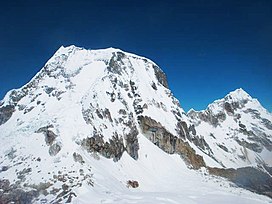Ranrapalca
| Ranrapalca | |
|---|---|
 Ranrapalca (on the left) and Ocshapalca (on the right) as seen from the north-east (near the Ishinca glacier) | |
| Highest point | |
| Elevation | 6,162 m (20,217 ft) |
| Prominence | 2,909 m (9,544 ft)[1] |
| Parent peak | Chinchey |
| Coordinates | 9°24′39.27″S 077°25′00.12″W / 9.4109083°S 77.4167000°W |
| Geography | |
| Location | Ancash, Peru |
| Parent range | Andes, Cordillera Blanca |
| Climbing | |
| First ascent | Northeast ridge 06/25/1939 - Hans Schweizer, Karl Schmid, Siegfried Rohrer and Walter Brecht (Germany)[2][3][4] |
Ranrapalca[5][6] (possibly from Quechua ranra stony, pallqa bifurcation, division into two parts)[citation needed] is a mountain in the Cordillera Blanca range in the Andes of Peru. It has an elevation of 6,162 m (20,217 ft).[6] It is located in the region of Ancash, east of Ocshapalca. Its territory is within Huascarán National Park, province of Huaraz, within the territory of the local communes Independencia and Tarica.[7]
Climbing
The northeast ridge (normal route) is of intermediate difficulty (rated D range according to the International French Adjectival System).[8] It consists in climbing a steep, rocky ridge from the Ranrapallqa-Ischinca col to the summit snowfields and 6,000 m and then traverse south of the knife edge summit.[9] An easier variant of the normal route consists in avoiding the northeast ridge.[5] From the Ranrapallqa-Ischinca col the summit snowfields can be reached climbing the easy snow slopes on the left of the ridge but this route, albeit slightly easier is more exposed to seracs and loose rocks. Many other routes exist, some of them quite difficult (such as the east ridge and south face, both rated TD+).[5]
First Ascent
Ranrapalca was first climbed by Hans Schweizer, Karl Schmid, Siegfried Rohrer and Walter Brecht (Germany) 25 June 1939.[2][3]
Elevation
Other data from available digital elevation models: SRTM 6132 metres,[10] ASTER 6108 metres[11] and TanDEM-X 6067 metres.[12] The height of the nearest key col is 3253 meters, leading to a topographic prominence of 2909 meters.[13] Ranrapalca is considered a Mountain Sub-System according to the Dominance System [14] and its dominance is 47.21%. Its parent peak is Chinchey and the Topographic isolation is 10 kilometers.[13]
Images
- Ocshapalca (on the left) and Ranrapalca (on the right), the Llaca Glacier and the Llaca Lake
- Vallunaraju, Ocshapalca, Ranrapalca (the snow-covered mountains on the right) as seen from Huaraz
External links
References
- ^ "Ranrapalca". Andes Specialists. Retrieved 2020-04-12.
- ^ a b Deutsch-Österreichische Alpenvereins expeditionen in den Peruanischen Anden.
- ^ a b "AAJ (American Alpine Journal)". AAJ (American Alpine Journal): 157. 1941.
- ^ Jill Neate, Mountaineering in the Andes, 1994
- ^ a b c Biggar, John (2020). The Andes: A Guide for Climbers and Skiers. Andes. p. 97. ISBN 9780953608768.
- ^ a b Alpenvereinskarte 0/3b. Cordillera Blanca Süd (Peru). 1:100 000. Oesterreichischer Alpenverein. 2005. ISBN 3-937530-05-3.
- ^ PERU, Autor: GEO GPS. "Base de datos Perú - Shapefile - *.shp - MINAM - IGN - Límites Políticos". Retrieved 2020-04-30.
- ^ Mesili, Alain (2004). The Andes of Bolivia : adventures and a climbing guide. Erik Monasterio (1st ed.). La Paz, Bolivia: Producciones CIMA. ISBN 99905-79-08-3. OCLC 58959078.
- ^ "Ranrapalca : Climbing, Hiking & Mountaineering : SummitPost". www.summitpost.org. Retrieved 2021-08-17.
- ^ NASA, Jet Propulsion Laboratory. "Shuttle Radar Topographic Mission - Filled Data V2". Retrieved 12 April 2020.
- ^ "ASTER GDEM Project". ssl.jspacesystems.or.jp. Retrieved 2020-04-14.
- ^ TanDEM-X, TerraSAR-X. "Copernicus Space Component Data Access". Retrieved 12 April 2020.
- ^ a b "Ranrapalca". Andes Specialists. Retrieved 2020-04-12.
- ^ "Dominance - Page 2". www.8000ers.com. Retrieved 2020-04-12.



